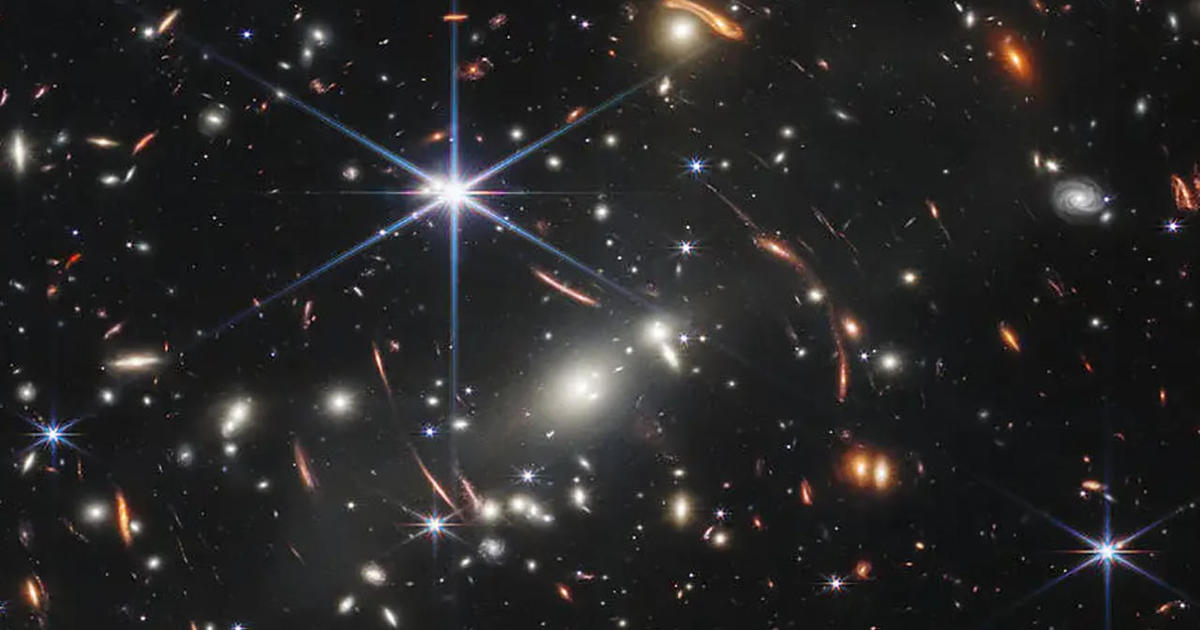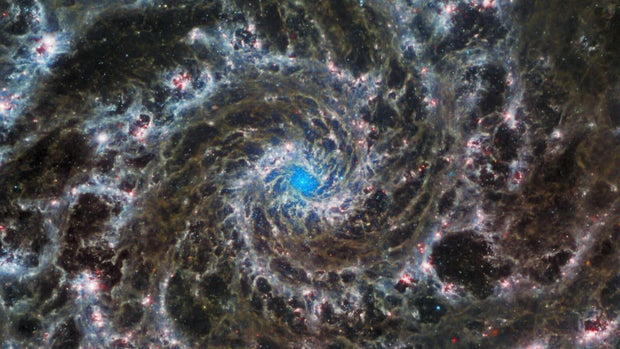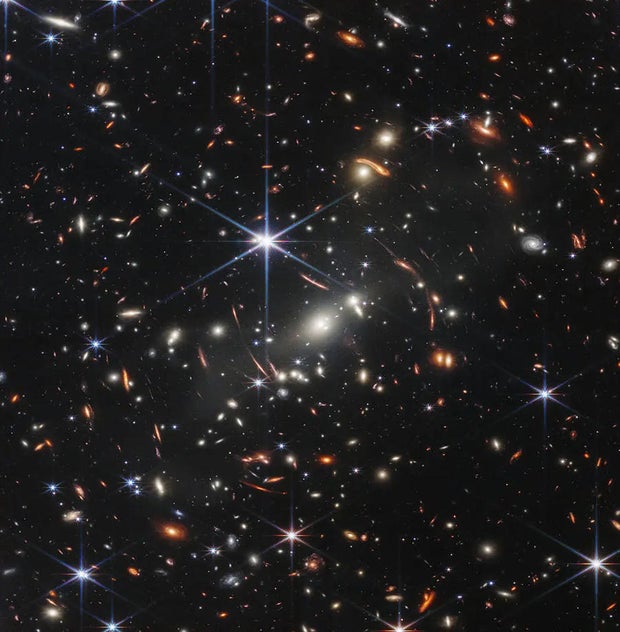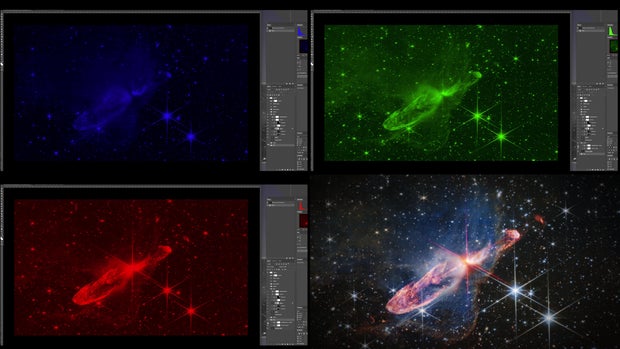The story of Christmas includes a miraculous astronomical sight. However this Christmas, we’re blessed with an abundance of latest miraculous visions from the skies, courtesy of the James Webb House Telescope, which lifted off on Christmas Day two years in the past … from Jupiter and its rings (a mere 385 million miles away), to the Carina Nebula (7,500 light-years away), the Phantom Galaxy (32 million light-years away), and the deepest areas of area (13 billion light-years away).
NASA, ESA, CSA, STScI
In 1989, NASA started interested by a successor to the Hubble Telescope. The brand new machine would have huge gold-plated lenses that might detect infrared mild – invisible to our eyes, however able to passing by mud and gases, 100 instances farther into the universe. The Webb would even be a lot greater than the Hubble: three tales tall and 70 ft broad, too large to suit into any present rocket. NASA’s answer? Fold it up.
Scott Willoughby oversaw the Webb’s building at Northrup Grumman. Ten days earlier than launch in 2021, he defined to “Sunday Morning” the complexity of the unfolding course of: “They’ve issues which might be referred to as single-point failures – this has to maneuver this manner, and there is solely certainly one of ’em. And Webb has over 300 of these.”
300 issues that needed to go precisely proper.
It took nearly seven months for the telescope to unfold, calibrate, and attain its orbit, one million miles from Earth. So now, on the second anniversary of the launch, we requested the way it went.
“It actually went excellent, as near excellent as one might’ve even imagined,” Willoughby mentioned. “Folks truly requested after, ‘Did you overblow how laborious this was?’ And the reality was, practising for all the pieces as if it might go incorrect was the very best preparation for making it go proper.”
NASA, ESA, CSA, STScI
As a result of infrared is a type of warmth, it needed to get chilly—minus 400 levels. Even the solar’s warmth would blind the telescope to the faint infrared indicators from area. And so, a big solar protect – an umbrella, mainly – was deployed to dam out any shred of the solar’s mild from reaching the telescope’s lenses. “There’s just one star in your entire universe we’ll by no means see, and it is ours, it is the solar,” Willoughby mentioned.
Lastly, the science might start.
At NASA’s House Telescope Science Institute in Baltimore, Jane Rigby, the Webb’s chief scientist, talks to the telescope from the flight management room, drawing the information that has been collected. “The elevator pitch for the Webb Telescope was to get the infant photos of the universe,” Rigby mentioned. “Now we have delivered precisely what we promised on that matter. We have gone from mainly ignorance about what that first billion years of the universe was like, to having it in crisp excessive definition.”
One other Webb mission: analyzing distant planets, to see if any of them have atmospheres like ours, possibly to seek out one human beings might reside on. However how can a telescope know what’s in a distant planet’s ambiance? Seems, when a planet passes in entrance of its star, the weather of its ambiance—oxygen, nitrogen, no matter—block particular bands of sunshine. Analyzing how the spectrum of sunshine adjustments can reveal what the ambiance of that planet is like.
The Webb has already studied the atmospheres of dozens of distant planets. On one, the exoplanet K2-18 b, it discovered carbon dioxide and methane, which means that it has oceans. [It’s a mere 120 light-years from Earth.]
Rigby mentioned, “It is such a pleasure that this telescope is working so properly, as a result of it was constructed rather well by the engineers.”
However not all of the Webb headlines have been triumphant. One, in June 2022, did not sound good in any respect:
However Scott Willoughby was not frightened: “We designed the mirrors to get hit by micrometeorites – you recognize, small particles, say grain of sand or one thing like that. However while you’re really speaking about one small spot in one thing 22 ft throughout? The affect of it was actually irrelevant. It truly did not affect science in any respect.”
However there have been additionally some questions in regards to the pictures. Was NASA manipulating them? Colorizing them? NASA picture consultants Joe DePasquale mentioned, “That query truly comes up lots: ‘Is what Webb sees actual?'”
He and Alyssa Pagan can reply questions on colorizing, as a result of they’re those who do it. “It is our job to have the ability to translate that mild into one thing that our eyes can see,” DePasquale mentioned.
Because it seems, there’s loads of mild that individuals cannot see, like ultraviolet mild, which bees can see; or infrared mild, which pit vipers can see. Ultraviolet mild travels in very quick waves; infrared waves are for much longer. And that is what guides the colorizing course of.
Pagan mentioned, “We’re taking the shortest wavelengths, making use of the bluer colour; the center wavelength, that is the inexperienced; after which the longest wavelength will get assigned the crimson. That is what we predict is the truest illustration of what we might presumably see, if we might see an infrared mild.”
NASA, ESA, CSA, Joseph DePasquale (STScI), Anton M. Koekemoer (STScI)
In simply the primary 12 months of Webb observations, scientists revealed greater than 600 papers primarily based on its discoveries. And based on Willoughby, the telescope has yet one more little reward for us this Christmas: “Once we launched, we by no means needed to appropriate our personal rocket engines,” he mentioned. “We saved all of that gasoline, and successfully on Day One, doubled the launch of the mission from ten years to twenty.”
So, for not less than 20 years, scientists around the globe will maintain peeling again the mysteries of the universe, and the Webb will maintain sending again photos that amaze and amuse us, from the optical quirk referred to as the query mark…to the galaxy cluster that NASA calls the “Christmas Tree,” and past.
For more information:
Story produced by Younger Kim. Editor: Karen Brenner.





